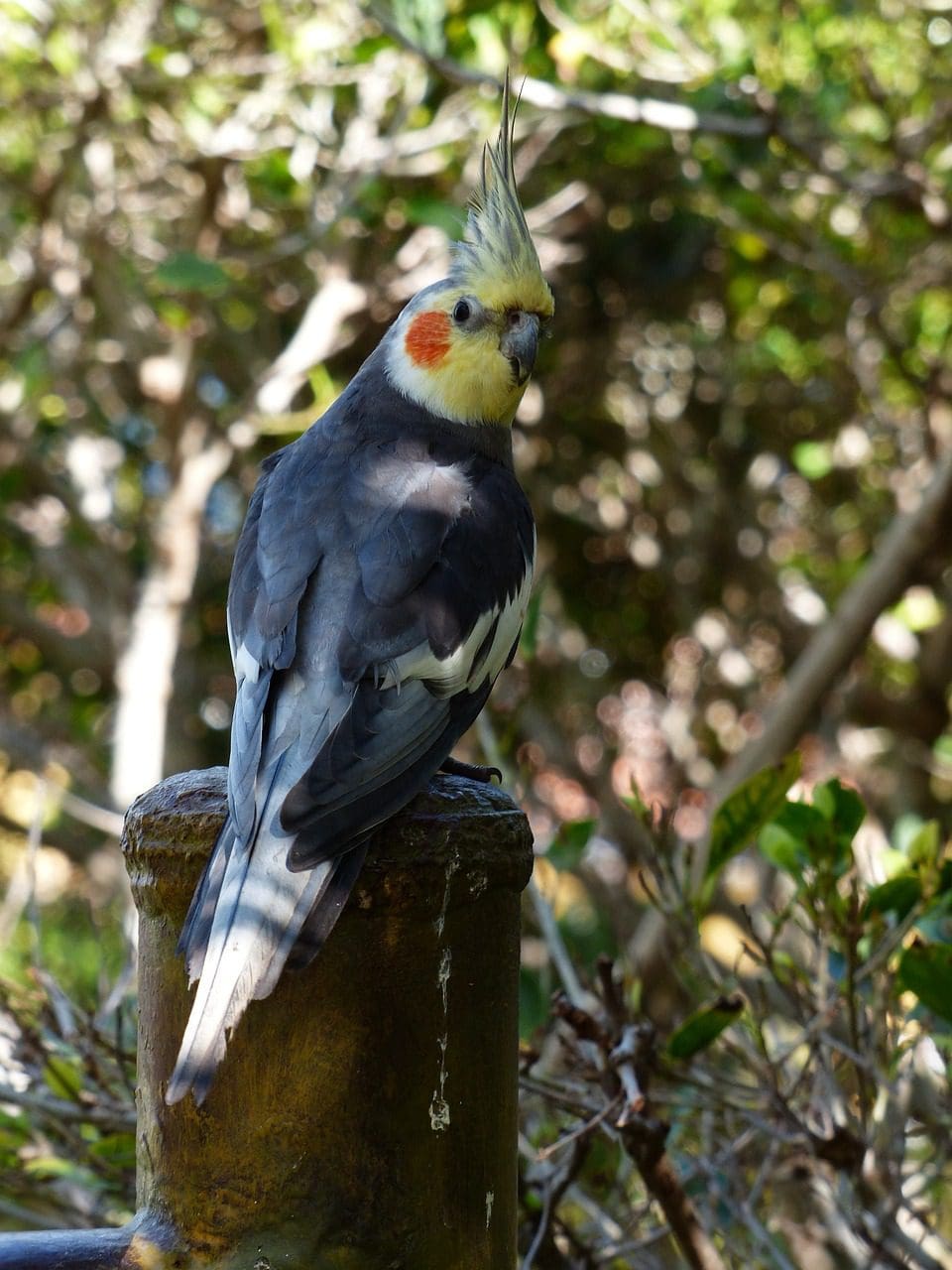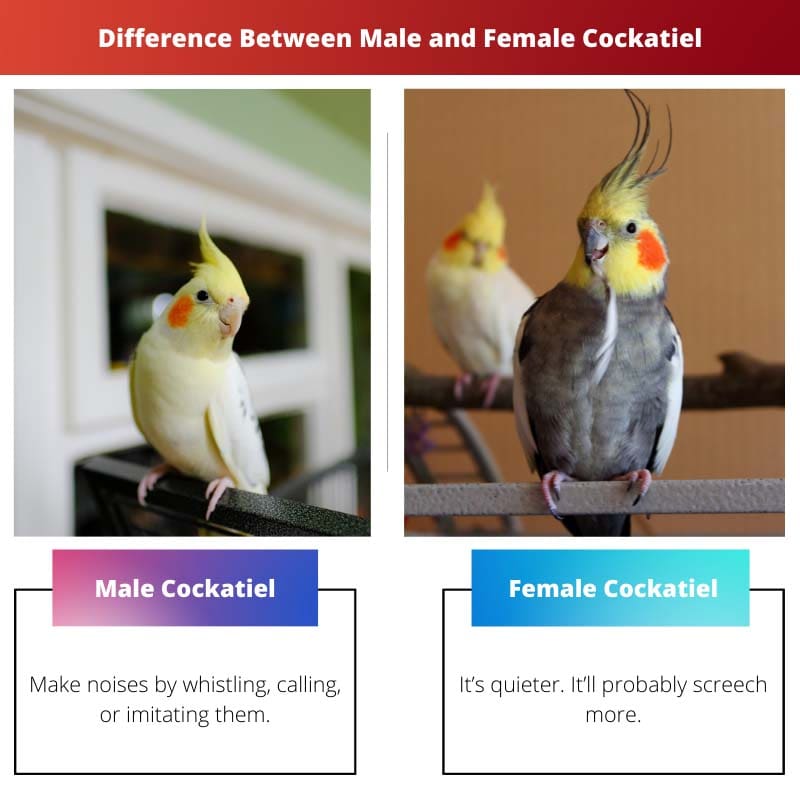Cockatiels are now the world’s second most popular companion parrot. They’re intelligent, engaging, interactive, and attractive. They have some distinct personality traits, and respecting them for who they are is essential to coexisting with Nymphicus hollandicus.
Not all parrot species are “sexually dimorphic,” meaning the males and females may be distinguished.
Key Takeaways
- Male cockatiels have brighter and more colorful plumage, while females have duller colors and more subdued markings.
- Males can mimic sounds and whistle tunes more effectively, while females produce simpler, less melodic vocalizations.
- Female cockatiels lay eggs and need a calcium-rich diet, while males have no dietary requirements.
Male vs Female Cockatiel
Male cockatiels have a few physical and behavioural traits that can help distinguish them from females. Physically, male cockatiels tend to have brighter, more vivid coloring than females. Female cockatiels also have some physical and behavioural differences from males. Physically, females tend to have more muted coloring than males, with less distinct patterns.

Male cockatiels are inquisitive, extroverted, and flaunting their abilities. They are louder, and will love spending time with them. Males will flock to the areas of the cage with the greatest activity, such as where other birds and humans are present.
He’ll even live, jumping about and whistling to get attention. Male cockatiels aren’t afraid to express their distaste for anything, whether it’s for food or for failing to attract attention.
Female cockatiels are quiet and timid by nature, and they may withdraw if there is a lot of commotion and activity. They will remain at a safe distance and prepare to flee if they perceive danger.
They like snuggling up on their favourite human’s shoulder and will seek company. Many ladies maybe a little sassy.
Comparison Table
| Parameters of Comparison | Male Cockatiel | Female Cockatiel |
|---|---|---|
| Sounds | Make noises by whistling, calling, or imitating them. | It’s quieter. It’ll probably screech more. |
| Body Look | Grey plumage with a darker hue. | Grey plumage that is lighter in color. On the underside of the wings, there are a few faint yellow dots. White spots will appear on pearled-breed females. |
| Features | Puffs up his chest, struts about sing. | Coos, as she raises her tail, droops her wings and lowers her back. |
| Mirror | Fascinating by the mirror. | The mirror isn’t interesting. |
| Colors | More vibrant colors. | More muted colors. |
What is Male Cockatiel?
Male cockatiels vary from females in a number of ways. If one is well-socialized, he will be outspoken in his need for attention.
He’ll want to get to the section of the cage nearest to humans or other birds, and he’ll be excitedly moving back and forth, trying to discover a way to get to you. Males strut, jump, and bobble to show off their “things,” and they tend to burst forth with noises.
To attract more attention, they may peck vigorously (like a woodpecker) at the perch or a tabletop. This may be part of their courting for a female but they can provoke it by tapping nails on the table so he hears it.
A group of whistles is the most frequent collection of sounds. The species’ general contact call, as described for the female, is one of them.
Even if he isn’t reacting to another bird, he will cry out with whistles. These whistles have more complex and complex tones. Male cockatiels are the species’ “talkers.”
Despite the fact that they don’t have a large vocabulary and don’t all “speak,” they will mimic human language in a sing-song melodic manner as part of a larger piece. Other noises around the home, such as beeps, clicks, or electrical sounds, are imitated by these men.

What is Female Cockatiel?
Female cockatiels are timider and reserved, withdrawing when there is a lot going on. They are not aggressive in the sense that they do not go toward a potential danger.
They will keep a low profile and, if necessary, escape danger. Females will seek out their favourite people and initiate contact calls, but they are more selective about who they respond to.
Female cockatiels, in general, do not mimic noises or speak much; even so, they may have a limited vocabulary of one or two words. The female cockatiel has only one call.
It’s a harsh whistling “whoop” sound that’s employed as a contact call to react to other cockatiels or a familiar human voice or whistling call from outside birds.
Each woman will have her own distinct personality. It’s due to the influence of early socialization (or lack thereof), the existence of different amounts of hormones, and if she saw a model on which to base her conduct.
It’s most likely due to the growing ovary’s hormones being temporarily out of balance as it develops.

Main Differences Between Male and Female Cockatiel
- Male Cockatiels make noises by whistling, calling, or imitating them, whereas female cockatiels are quieter. It’ll probably screech more.
- Male Cockatiels Grey plumage is darker in color, while female cockatiels Grey plumage is lighter. There are a few tiny yellow spots on the underside of the wings. Pearled-breed females will develop white patches.
- Male Cockatiels puff up their chest and strut about singing, whereas female cockatiels coo as she raises their tail, droops their wings, and lowers their back.
- Male Cockatiels are fascinated by mirrors, whereas female cockatiels are not much fascinated by mirrors.
- Male Cockatiels are more vibrant in colors, whereas female cockatiels are more muted in colors.

- https://avmajournals.avma.org/doi/abs/10.2460/ajvr.78.6.745
- https://www.sciencedirect.com/science/article/pii/S0168159100001726

I’ve gained valuable knowledge about male and female cockatiels from this article. It’s crucial to understand and respect their individual needs and behaviors.
I appreciate the depth of information presented in this article. Learning about the distinct behaviors of male and female cockatiels is crucial for creating a nurturing environment for these birds.
The insights shared in this article provide valuable information for anyone interested in learning about cockatiels. Understanding the characteristics of male and female cockatiels is important for their care.
Thanks for the informative article about cockatiels! I appreciate the insights into the distinct characteristics of male and female cockatiels.
The details provided here about the differences between male and female cockatiels are truly enlightening. It’s great to understand the unique traits of each gender.
This article offers a comprehensive overview of male and female cockatiel behaviors. The differences in sounds and physical appearances are fascinating.
This article serves as an excellent educational resource for those wanting to understand the behavioral differences between male and female cockatiels. It’s essential to acknowledge and embrace their unique traits.
The comparison table is particularly helpful in distinguishing between male and female cockatiels. It’s essential for bird enthusiasts to be aware of these differences.
The detailed descriptions of male and female cockatiels’ behaviors are both informative and insightful. It’s essential to recognize and respect the differences between these intelligent birds.
I find the detailed descriptions of male and female cockatiels’ behaviors very intriguing. It’s vital to recognize and appreciate their distinct personalities.